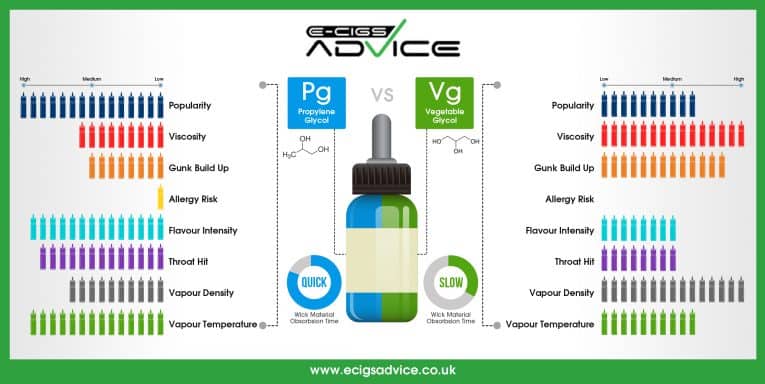WHY DOES E-LIQUID CONTAIN VG & PG?
People who don’t like e-cigarettes keep saying “It’s not just water vapor!” They’re right; it’s not. What they’re wrong about is that this is somehow worrying.
Most of that cloud coming from your e-cigarette is either propylene glycol (PG), vegetable glycerine (VG) or – more likely – a mixture of both.
About 95% of your favorite e-liquid is PG or VG. There are two reasons for that. One is that pure nicotine would be far too strong to vape; it would be extremely harsh, and could make you ill.
The other reason is that it’s PG and VG that create most of the vaping experience.
Think about the water vapor that comes from a boiling kettle: You could inhale that, but would it give the same sensation as smoke? No – it’s much too insubstantial.
One of the biggest technical challenges for Hon Lik, who invented the modern electronic cigarette, was finding a liquid that was safe to inhale but would recreate the feel of smoke.
Without that sensation e-cigarettes wouldn’t be a satisfying alternative, so it was a vital part of the concept.
After lots of tests Hon decided that propylene glycol was the ideal liquid. It’s been used in inhaled medication for decades, and is a common food additive.
It also feels like smoke when inhaled, so it was perfect for Hon’s plans.
Early e-cigarettes used a pure PG liquid, with only nicotine and flavorings added. As users began experimenting, however, VG started to appear.
Over the past few years it’s become a lot more popular. Pure PG liquids are now quite rare, and most have at least 50% VG content.
Glycerine is another common substance. Like PG it’s often used as a food additive, and is found in many medications, skincare products and soaps.
It’s non-toxic, inexpensive and high purity pharma-grade glycerine is easily available. It also hasn’t suffered from some of the attacks that PG has.
Many health campaigners dislike e-cigarettes, and a common line they use is that the ingredients of the e-liquid might be harmful to inhale.
Their main target is nicotine, but PG is a close second. If you hear anyone talking about how e-cigarettes contain “a chemical used in antifreeze” they’re talking about PG.
What they never say is that it’s used in some modern antifreeze because it’s not toxic. Some also claim that PG causes throat irritation.
Yes, it does.
That’s actually a positive thing, as we’ll see shortly.
WHAT IS BEST?
If VG is less controversial than PG, why hasn’t it completely replaced it? It’s simple. Both liquids have strengths and weaknesses. Neither of them is a perfect e-liquid base on its own.
Everyone has different tastes though, and some prefer one to the other. Most vapers are somewhere in the middle, and prefer various blends.
If you’re wondering what suits you best, it helps to know the differences between the two.
Here’s an introduction…
PROPYLENE GLYCOL
PG is a clear liquid which is thicker than water and has a slightly oily feel.
It isn’t an oil, however – an important point, because inhaling vaporized oil is dangerous and can cause fatal lung diseases.
PG is actually an alcohol, so it has low freezing and boiling points.
That’s why it makes good antifreeze, and it’s also why it’s good for e-liquid; it turns into vapor without getting hot enough to cause scalding.
One of the most important features of PG is that it replicates the “throat hit” you get from smoking. Maybe you were wondering, earlier, why it’s a positive thing that PG causes throat irritation.
Well, this is why. Tobacco smoke also irritates your throat; once you get used to this it’s actually one of the satisfying parts of the smoking ritual.
Inhaling PG vapor gives the same feeling, but the irritation doesn’t last very long and won’t cause permanent throat damage – tobacco smoke will.
Another good thing about PG is that it’s very good at transporting flavors. The more PG there is in a liquid, the better it will taste.
PG has a slightly sweet taste but it isn’t strong enough to really interfere with the flavoring.
PG is thicker than water, but not excessively. It travels well along wicks, making it ideal for smaller atomizers like the popular CE4 clearomiser.
There are two real drawbacks to PG. One is that it doesn’t produce much visible vapor.
If you like a cloud you can see, pure PG liquid is likely to be disappointing (although this does make it perfect for stealth vaping).
The other is more serious. Around two percent of people are sensitive to PG, and can suffer discomfort or skin irritation.
If you find yourself developing a rash after vaping PG-heavy liquid, try a higher VG mix.
VEGETABLE GLYCERINE
VG is also an alcohol, and evaporates at a low temperature. It’s roughly similar to PG, but there are some important differences too.
One reason VG is used in soap and skincare products is that it’s very non-irritating. That’s great for face cream, but for vaping it has a drawback – high-VG liquids give very little throat hit.
Vaping more nicotine will compensate for that, either by using a higher-strength liquid or a more powerful device that creates more vapor.
The good news here is that even if you’re sensitive to PG, VG should be fine to vape. Nobody seems to be sensitive to it.
Another issue is that VG isn’t as good at transporting flavors, so you might notice a more muted taste.
It has quite a noticeable sweet taste of its own, too; one of its uses in foods is as a sweetener or sugar substitute.
VG is much thicker than PG; in fact it’s so thick that pure VG liquids won’t work well in many atomizers. It wicks so slowly that the coil can run out of liquid, causing an unpleasant dry hit.
To get round this, VG is usually blended with PG or distilled water to thin it.
Pure VG liquids do work fine in drippers though, and the latest generation of sub-ohm tanks can handle higher VG mixes than older designs.
The big advantage of VG is in the thick vapor it produces. A cloud of VG is very visible and dense, which is exactly what many vapers are looking for.
WHAT MIX SHOULD I USE?
So now you know what PG and VG are, and why the different mixes make a difference to your vape.
At the end of the day it’s a personal choice what ratio you prefer, but high VG mixtures are definitely becoming the most common option.
If you’re just starting, try a 50/50 mix and see how you get on with that. Then you can try increasing the proportion of VG to find your ideal mix.
Don’t let anyone tell you that you’re vaping the wrong blend – it’s entirely up to you!
What PG/VG mix do you prefer to use?

